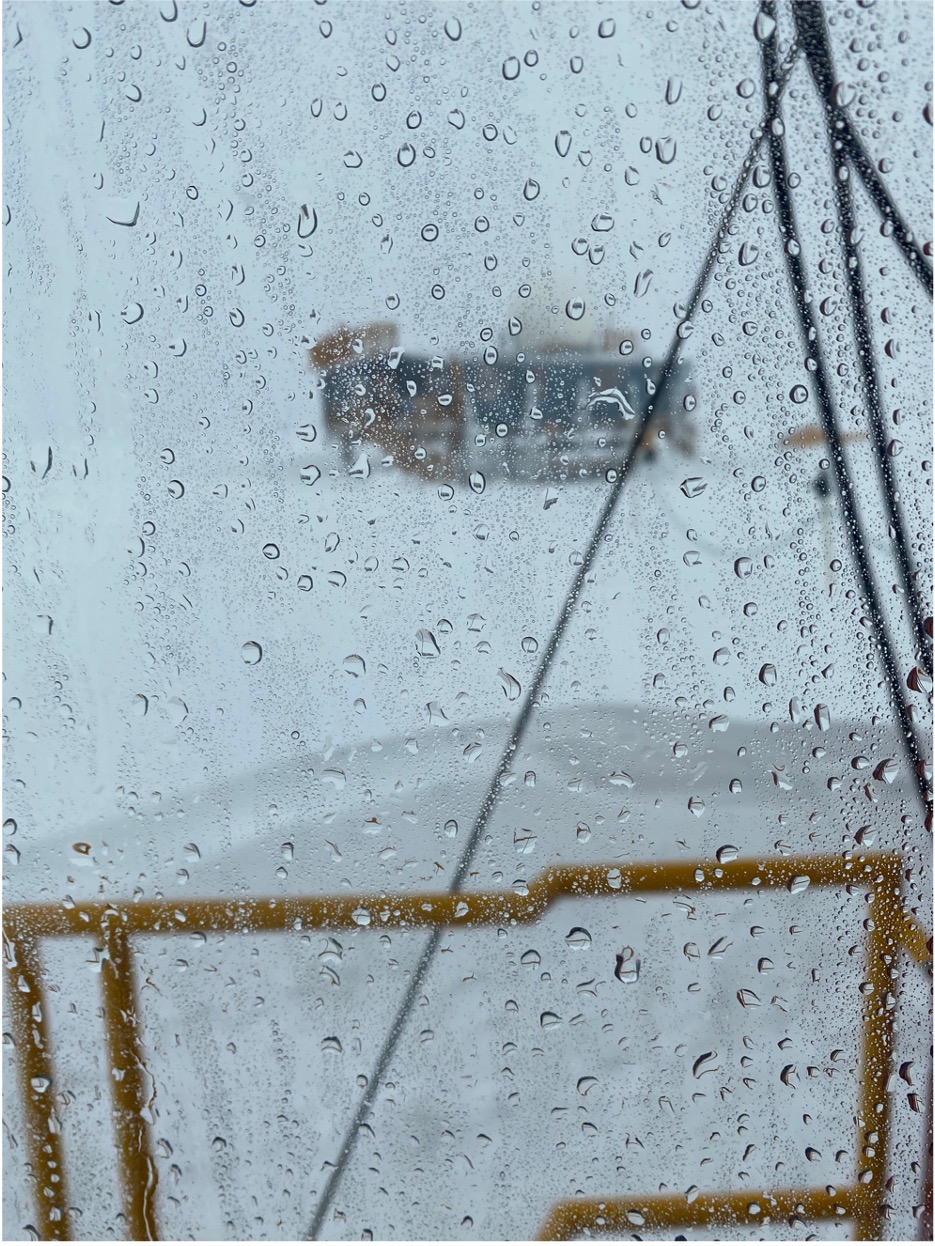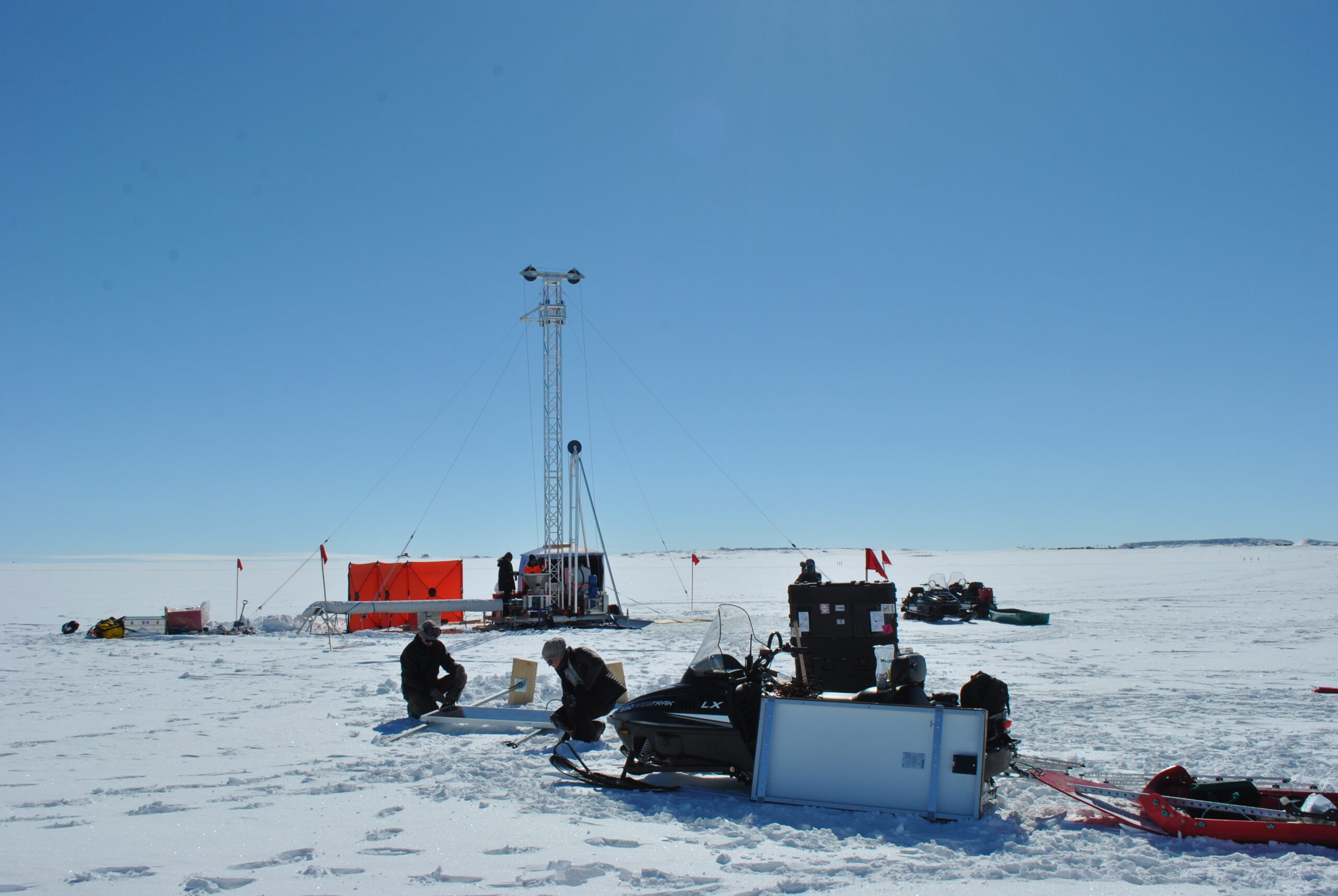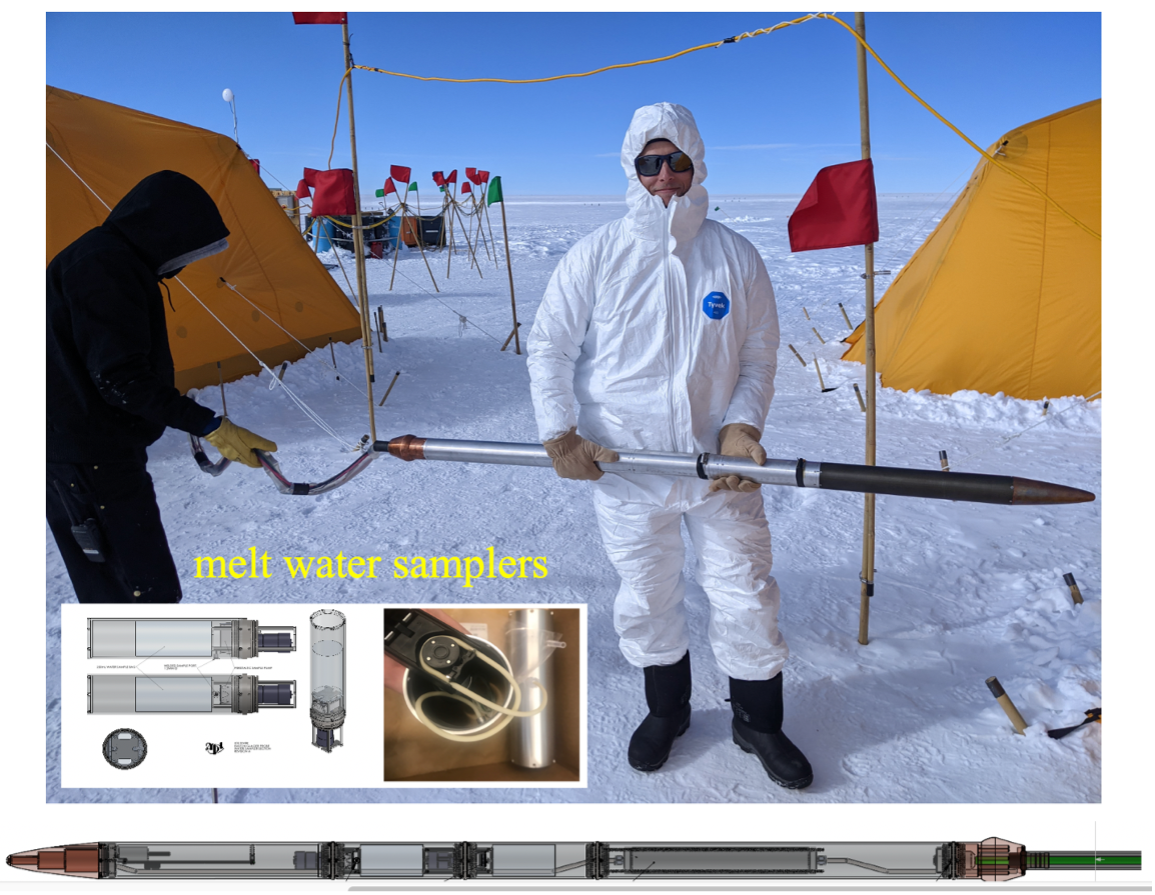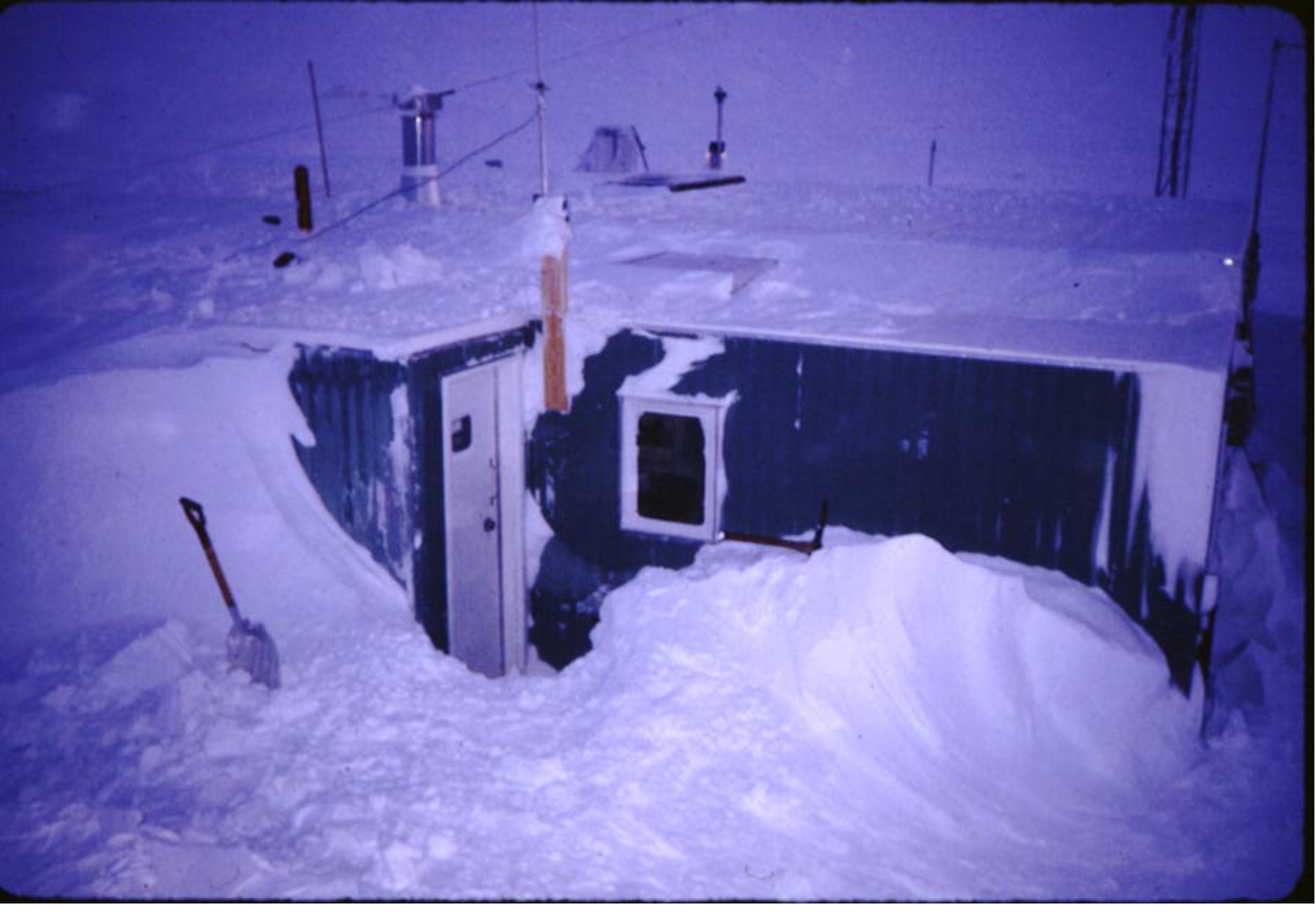Rare rain event occurs at Summit Station
During the summer of 2021, it rained at Summit Station on August 14th (Figure 1). Liquid water occurs often in the atmosphere at Summit in a couple of different forms. Researchers often observe supercooled liquid water clouds over the station in summer. Most of the time, these water droplets are mixed with ice crystals to create “mixed-phase” clouds. Station personnel also observe rime on structures. Riming occurs when supercooled water droplets collide with a surface, then freeze, creating an icy glaze. This is something that the science technicians must contend with to keep outdoor instruments happy and healthy.
But the event on August 14th was unusual because the clouds over Summit Station precipitated rain for most of the day, in fact, for about 20 hours. During this time, the surface temperature was slightly above freezing. Melt events are quite rare at Summit. Alley and Anandakrishnan (1995) analyzed the GISP2 ice core, which was drilled at Summit Station, and concluded that about 50 melt events occurred at Summit over the last 10,000 years. But recently, there have been multiple melt events in 2012, 2019, and 2021. During most of these events, the surface temperature has warmed to 0 C, but it has not rained. The August 14th event was definitely one for the record books and future ice core records!
Alley, R. B., & Anandakrishnan, S. (1995). Variations in melt-layer frequency in the GISP2 ice core: implications for Holocene summer temperatures in central Greenland. Annals of Glaciology, 21, 64–70. https://doi.org/10.3189/S0260305500015615

Figure 1. Photo by Alicia Bradley, PFS Science Technician
Radio Neutrino Observatory in Greenland (RNO-G)
The RNO-G collaboration completed its first deployment season at Summit during the summer of 2021. An international team of scientists from the US and Europe joined forces with a drill crew from the British Antarctic Survey (BAS) to build our first three radio-detector stations, which were installed in the field at distances of 1-3 km from Summit Station. Using these detector stations, the goal of RNO-G is to measure the faint and ultra-fast radio pulses (the ‘Askaryan’ signal) from ultra-high energy (UHE) neutrino-induced interactions in the ice sheet, and to ultimately quantify and better understand the astrophysical origin of these immensely energetic particles. The detectors have successfully started acquiring data for commissioning and initial data analysis.
The RNO-G detector station is optimized for low-power autonomous operation, efficient deployment, and high sensitivity -- in order to achieve the science goals, the receivers are designed to have sensitivity to radio-frequency power as low as a few picoWatts (~10-12 Watts) and to record pulses with nanosecond (10-9 seconds) timescales. Each station comprises both deep antennas, installed in boreholes at 100m depth, and antennas installed at the surface that serve as receivers for radio signals from cosmic-ray particle airshowers (Figure 2). As expected, these surface antennas have also demonstrated good reception to handheld radios and other radio-frequency noise from Summit Station. All antennas are wired to a central instrument vault, which contains the primary data-acquisition system, trigger, wireless communications, and an off-grid renewable power system. These first three stations are fully solar powered, with a plan to incorporate wind turbines on a few future stations in 2022 to achieve closer to 100% detector uptime. With assistance from the Summit staff, the team installed an LTE base-station unit and large panel antennas at the Big House this season, which serves as the primary wireless data-transfer communications link to the remote stations.
The RNO-G deep antennas provide the best radio sensitivity for the detection of UHE neutrinos and are installed down boreholes made with the BAS “BigRAID” 11-inch diameter auger drill. This drill was operated on a polar ice sheet for the first time this season and, although some first-season challenges were perhaps unsurprisingly encountered, nine 100m science boreholes were successfully drilled at the three remote sites, as well as an outfall hole for the Big House. Drill upgrades are currently underway to streamline the drilling process for next season. The boreholes are equipped with deep antenna strings that are lowered into place using a custom-made ‘deployment hut’ on cargo sleds, which is towable by snowmachine and can be precisely aligned over a borehole by hand.
As of early October, the three stations are now in a low-power mode to preserve the batteries over the winter months, having operated continuously in either calibration or science-data mode since the installation was completed in late July. The RNO-G team is looking forward to the 2022 field season, which will see continued operations of these first stations and the deployment of an additional 7 detector stations, another step in the staged approach to build the full 35-station RNO-G radio array.

Figure 2a. Deployment of the Radio Neutrino Observatory at Summit Station, Greenland. Photo by RNO-G Research Team

Figure 2b. Deployment of the Radio Neutrino Observatory at Summit Station, Greenland. Photo by RNO-G Research Team
Clean Sampling of Englacial Meltwater at Greenland Summit Using a Recoverable Ice Melt Probe
Ice melt probes are attractive candidates for deploying instruments within and beneath ice sheets at logistical costs much lower than those of conventional drilling, and are also a prospective technology for accessing subglacial oceans in the outer solar system. Classical ice melt probes descend into ice using electrical power supplied from the ice surface, via wires that spool out from the descending vehicle. Water in the melt hole above the probe refreezes, thus preventing recovery of the probe and instrumentation, as well as any samples of englacial meltwater or subglacial waters. The University of Washington Ice Diver was first developed as a classical melt probe and proven in the Greenland ablation zone to 400 m depth (with NSF MRI support). We have, on the basis of modeling by Hills et al. (Annals of Glaciology 1-5, 2020), since investigated the use of anti-freeze injected into the melt hole above a descending probe to prevent refreezing while avoiding clogging the hole with slush. Such an approach also allows the probe tether to be deployed from the surface and thus enables use of tethers, e.g., including fiber for Raman Distributed Temperature Sensing, that cannot be spooled within a melt probe that uses modest electrical power.
In May and June 2021 at Summit Station, we used a modified version of the Ice Diver (Figure 3) to test the simplest antifreeze approach indicated by modeling. From the ice sheet surface to 65 m depth, melt water produced by the probe flowed laterally into surrounding firn and did not accumulate above the probe; below that depth we observed melt water retention in the hole. We injected methanol (our antifreeze) 1.5 m above the top of the descending probe at a rate specified by modeling for the particular diameter of the probe (8 cm), descent rate, and ice temperature (-31C). We proceeded to a depth of 103 m below the ice sheet surface, continually feeding the tether down to the probe from the ice surface through the methanol/water mixture in the hole. We encountered no resistance from slush or refrozen ice as we recovered the probe through the liquid-filled hole. Moreover, 36 hours after probe recovery we lowered the probe again, without obstruction, to the previous depth before recovering it again. We have thus validated the simplest anti-freeze strategy indicated by our modeling, in the field, at temperatures characteristic of large parts of the Greenland and Antarctic ice sheets.
In parallel, we have extended methods for clean sampling of englacial melt water for microbiological analysis, building on earlier work by Mikucki and co-workers using the German Ice Mole melt probe on Taylor Glacier, East Antarctica. These methods begin with decimation of microbes on the surface of the probe prior to deployment. Results from these assays indicate that the Ice Diver entered the borehole cleanly, i.e., ATP measurements from the probe surfaces were below the NASA “threshold cleanliness limit” of 2.3 x 10-11 mmol ATP per 25 cm2 established for the Mars Science Laboratory. Furthermore, we used hardware (tested in May 2018 on Mt. Baker, WA and subsequently refined) to cleanly acquire 120 ml of englacial melt water samples from the final probe depth of 103 m, analysis of which is now underway.
Finally, in September 2021 NSF announced selection of new Science and Technology Centers including the Center for Oldest Ice Exploration (COLDEX, Ed Brook of Oregon State University, PI). As part of the work of this center, the non-recoverable version of the Ice Diver will be modified to incorporate an optical dust logger, in collaboration with Ryan Bay (UC Berkeley), so as to acquire age-depth information for Antarctic ice core site selection. Planning to commission the new system at Summit in Summer 2023 is now beginning.
ACKNOWLEDGMENTS: This work was supported by NSF Awards 1542977 and 1744787, D. Winebrenner, PI, and NASA SESAME grant NNN12AA01C, T. Cwik, PI, with prior sampling melt probe development supported by NASA COLDTECH grant NNX17AF68G, D. Winebrenner, PI. We would like to thank Battelle Arctic Research Operations, especially Polar Field Services for extensive, expert support in Greenland.

Figure 3. (top) Photo of J. Burnett holding the University of Washington Ice Diver at Summit Station, Greenland in May 2021 prior to deployment. (top, inset) Photo and schematic drawings of clean melt water sampling hardware using peristaltic pumps and autoclaved tubing and sample bags. (bottom) Schematic drawing of the Ice Diver showing placement of sampling hardware.
Retired at age 24: Retrospective of the Greenhouse - 1997 to 2021
The summer season of 2021 saw the final decommissioning of the "Greenhouse" at Summit, first known and commissioned as the "Atco building" in the spring of 1997. The Greenhouse joined the Bighouse that spring as the second year-round, hard-sided structure at Summit (besides the drill dome). There had been other small hard-sided buildings (a mechanic's shop module tacked on to a weatherport, a 'bathhouse' module, and a towable sauna) but all would be packed away onto the berms for winter. It is safe to say that the addition of the Greenhouse was the beginning of the transition from Summit being a "camp" to being a "Station". Before the Greenhouse, there was no indoor berthing at Summit, and the only heated structure was the Bighouse. The Bighouse was also the only building with water, although power was distributed to the mechanic's and science weatherports and to the Science Trench.
The Greenhouse was designed by architect Winston Yan, then of the University of Nebraska, and constructed by Atco, a firm specializing in Arctic modular structures. Because it was unknown at the time whether year-round operation of Summit would be scientifically fruitful or even logistically feasible, the structure was designed to be easily repurposed with the lab and kitchen modules capable of fitting in the cargo hold of a C-130. The "bridge" section between the modules was built on-site and at the time was configured as 4 bedrooms around a central common space. Each of the 4 winter-over crew was allocated a bedroom, which were all outfitted with bunk beds; presumably with possible double-occupancy in mind. Within about 20 minutes of the "last plane out" departing in the fall, however, 3 of the 4 bunk beds were rendered into single beds with quick work of a hacksaw.
Yan, as the designer of the building, was deeply interested in the interaction between the building itself and its occupants, and how it impacted their mental state. Each week he requested the winter-over crew to answer questions in a survey designed to track our activities, our mental health, and our feelings about the structure in which we lived. Questions included the percentage of time we spent working outside, spent working inside, by ourselves or with others, including the mysterious percentage of time spent "doing other things in your own room". How we felt about the wall materials and colors (note that some of the interior walls in the living area are most certainly exterior walls). It became a weekly ritual for the crew to complete the surveys together over a cocktail.
The original plans for the winter of 1997-9 called for only the Greenhouse to remain heated throughout the winter. The Bighouse at that time was drifted in below grade level, and the assumption was that it was at or close to the end of its life. Things changed however, when the winter crew realized that a combination of factors allowed for the Bighouse to remain warm and quite functional through the winter. Being buried in insulating snow meant excellent insulation from the cold winter temperatures. Additionally, the generators installed for the winter-over were oversized for the station load, and required some additional load to stay healthy. Three 1500-watt space heaters solved the problem of maintaining sufficient load on the generators and keeping the Bighouse warm and habitable. The winter crew made extensive use of the Bighouse- as a gym (complete with a stationary bike and rowing machine, weights, and a climbing wall), and as a rec center (Friday night pizza and movie, anyone?).
As the crew understood, the health of the generators was crucial to the viability of the winter program, so a generator monitor was mounted prominently in the common area, adjacent to the mechanic's room. The station's first utilidor was extended from the generator modules in the shop (an oversized weatherport) to the Greenhouse, allowing the house to be heated with waste heat from the generator, a novel but now-common strategy at Summit. In case of a true power emergency, the Greenhouse was equipped with the preway diesel-fueled heater well known to occupants of jamesways and weatherports in both Arctic and Antarctic. To my knowledge that preway was only ever started one time, to test the system, and the resulting heat output drove most of us outside. Through the winter of 1997-98, the preway (or rather a tabletop we constructed on top of it) served as the platform for an actual small "greenhouse" of sorts, where the crew grew a few flowers and other plants.
The Greenhouse has seen many configurations over the years. From its beginnings as a stand-alone unit, through multiple moves and raises, being conjoined with the Berthing Module and then subsequently separated again. Through it all, the lab and kitchen modules remained essentially the same. The bridging structure and the vestibules changed; the original vestibules, for example, featured a 90 degree turn between outer and inner door, which would have been impossible to navigate with a patient in a litter or backboard. The Greenhouse served as an important science space, with several long term and campaign projects housed in the tiny labspaces as well as the suite of instruments installed on the roof of the building. Countless clean snow and ice core campaigns made use of the laminar-flow hood and clean room throughout the decades, and a generation of polar researchers were trained within the facility.
In the spring of 1997, the Greenhouse was constructed on a berm, several feet above grade level. By late fall of that year, drifts around the Greenhouse were such that access into each entry had to be maintained by a great deal of shoveling, particularly after storms. How much shoveling? A 2018 paper in the journal Cold Regions Science and Technology estimated a 'drifted in' Greenhouse to require the removal of ~4800 m3 of snow to clear completely. Certainly this volume is almost impossible to clear by hand, so heavy equipment is called in frequently to assist. At an estimated cost (from the 2018 paper) of $41,000 per year, snow removal for this structure has likely required close to 3500 operating hours, at a cost of almost $1 million in heavy equipment time.
Just as the commissioning of the Greenhouse marked the move from "camp" to "station" and sparked the development of the sprawling Summit we see today, it is our grand hope and vision that its decommissioning will pave the way for a new Summit; the Elevated Berthing Facility (EBF) is the first module of a new, elevated set of structures that will comprise the new station. Just as the winter-over presence spurred a science Renaissance at Summit in the late 90's and early 00's, we hope the newly reconstructed Summit will attract new science and ensure that the legacy of Summit Station continues to grow.
As we bid adieu to the Greenhouse, we must thank it for doing its original task- keeping those first 4 winter-over crew safe and warm through the winter, and showing that Summit Station can be a year-round, world-class platform for science covering a multitude of disciplines. Godspeed Greenhouse!

Figure 4: The Greenhouse - November 1997
